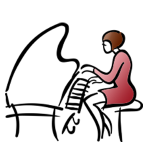NaBloPoMo Day 21!
Yesterday I gave a bit of history and background about Mahler and his 9th (including the rather important role his music has played in my life! 🙂 ). Today I have a few reflections on the piece, which I heard performed by the DSO this past Sunday.
Hearing a live orchestral performance brings to mind Many Great Truths — for example:
- Despite what numerous naysayers, nervous Nellies, and nattering nabobs of negativism like to say, classical music is not dead and the symphony orchestra is not obsolete.
- The sound of a live orchestra will never be equalled, even by the most audiophile’s-dream-come-true, money-no-object sound system you could imagine
- It is possible to listen to a piece of music lasting nearly 90 minutes, with no intermission, without feeling bored or impatient even for a moment
- The contrabassoon is frickin’ cool!
I sat in the lower balcony, which, in my opinion, is the best place to sit, because you can see all of the players, as opposed to the main floor, where you see only the front of the string sections. I adore the strings, don’t get me wrong, but the winds, brass and percussion are alot of fun to watch. And Mahler makes sure to provide plenty to watch in all quadrants of the orchestra.
Many portions of the work, especially in the first and last movements, are strikingly spare. Not only orchestrationally, with wonderfully exposed solo moments for different instruments — at least one player from each wind and brass section gets a turn, as well as a couple of percussion instruments and the principal string players — but also melodically. One of the marks of Mahler’s music is a kind of melody that undulates and unfolds and, sometimes, ascends bit by bit until, finally, it soars. And we get plenty of that in this piece, to be sure, but we also get passages where the melodic material distills down to bare-bones motives of two to four notes, tossed about in relative emptiness, floating above softly rustling strings or faraway sustained tones in the winds or brass.
These passages stirred up several vivid visual images for me (I hadn’t had a chance to stop for lunch before running from another event to this afternoon performance, so all of my senses were a little bit on edge — but I wasn’t hallucinating, I swear! 🙂 ): first, two rather famous movie scenes: from American Beauty, the video of a white plastic bag on a windswept city street, flitting back and forth in the air in a way that makes it seems alive — a seemingly insignificant scrap transformed into something beautiful; and second, the opening sequence from Forrest Gump, where a tiny white feather wends its way down from the treetops to alight on Forrest’s shoulder. I also thought of a blustery autumn day, with leaves dancing on the wind, fooling the eye into thinking they might coalesce into an airborne mosaic, but soon settling back to carpet the earth.
The opening of the first movement is one such passage. A prominent four-note motive in the harp is answered by a halting attempt at something heroic by a stopped horn. We settle into a gentle extended melody soon enough, and a satisfyingly grand arrival materializes by the 3-minute mark, but I was still working to process and savor the subtlety of that opening even as I was swept away on the crest of a brass crescendo. (And if any of these descriptions are too flowery for ya, then what the heck are you doing reading about Mahler? 😉 )
More to come tomorrow — be sure to tune in! 😀

If you enjoyed this post, would you consider…
Thanks — you make the world a better place! 🙂

